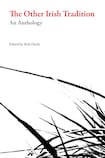
Writing is like fishing – the writer is trying to capture something. On one end of the scale – traditional storytelling – the writer is most concerned with what is caught in the net, while on the other end of the scale is the type of writing that is as interested in the construction and nature of the net, as in what is to be caught. The latter possibly reached an apotheosis back in 1729 with Laurence Sterne’s The Life and Opinions of Tristram Shandy, Gentleman.
As editor Rob Doyle writes in this excellent collection, “Tristram Shandy is a novel in which the narrator, seeking to tell the story of his life, never quite catches up with himself”. It is a novel whose intricate net is designed to catch only itself. It is, according to Italo Calvino, “the undoubted progenitor of all avant-garde novels of our century” and so may be considered a foundational text in relation to this collection of “experimental” writing. Yet even this alternative tradition is caught in the net of all nets – James Joyce’s Ulysses – and here is represented by the Ithaca section whose interrogatory form can be seen in some of Flann’s O’Brien’s work. In an excerpt from an early piece called Scenes from a Novel O’Brien builds the groundwork of insurgent characters who will not be written to order – later explored in his own novel At Swim Two Birds.
It is one of the many pleasures of this collection to see influence and similarity between works of different times: seeing in Desmond Hogan’s work the influence of Aidan Higgins in the accumulation of fragmentary details replacing the linear steps of traditional storytelling, particularly in the excellent Helsingor Station taken from Higgin’s collection Flotsam and Jetsam.
Hogan’s brilliant story Kennedy records individuals and moments with impressionistic strokes that build to a sweeping sense of time – history – made all the richer for the way it seems perceived as collections of random fragments, all shot through with the nowness of a rich sensuality of colours, imagery of clothing and eccentric (and often very funny) snap portraitures. In Dorothy Nelson’s brilliantly powerful and formally inventive excerpt from her novel In Night’s City can be seen a precursor to Eimear McBride’s A Girl is a Half-Formed Thing. Although Nelson won the Rooney Prize for this novel in the 1980s she never made the leap to full-time writer.
Exhilarating experiments
The reminder of writers who slipped from the main discourse of successful writing careers is another of this book’s joys. Desmond Hogan had seemed “poised to be a literary star... but he vanished from the literary world...Only in recent years he has reemerged from obscurity, rekindling the prestige he enjoyed during his period of youthful promise”. A writer who disappeared permanently into writerly obscurity is Hilary McTaggart who’s piece here, A Night on the Tiles, written in 1973, is stunningly strange and powerful. Her only book – Address Book – remains unpublished.
This collection feels timely in that there has been an explosion of “experimental” writing in Ireland within the last decade. It is the substantial success of writers like Kevin Barry, Eimear McBride and Mike McCormack that has widened the possibilities for such writing to flourish. Of the three only McCormack is represented here, with his terrific tridental tale. He is joined by many of the new wave: the exhilarating experiment that is Dave Lordan’s highly political work; John Holten’s riveting excerpt from his novel The Readymades which leaves a lasting impression of Elaine, a character brought fully to life. There is the editor’s own subversive intervention, the unique and detailed histories of the imagined artists of Jennifer Walshe, and Emer Martin’s Bukowskian adventures among people living on the edges of the centres of Europe in Paris, London, Berlin.
Doyle makes a point of including some material because he considers its content to lie outside the remit of the central canon, thus we have June Caldwell’s hilarious story of Sub/Dom, Leitrim Flip which, though driven by a cartoony energy, is a psychologically subtle exploration of power. It shares an honesty with Philip Ó Ceallaigh’s gaze on male lust in The Song of Songs. While Anakana Schofield’s excerpt from her novel, Martin John, employs fine formal experiment to explore dark materials.
Unique reading experience
The inventiveness stretches back in time to other forgotten originators: Alf MacLochlainn starts off all Robbe Grillet before morphing into something Flann-strange, tinged with it’s own unsettling oddness. And surely Flann the man was influenced by Eimar O’Duffy, Ireland’s great forgotten satirist, who’s bit from his excellent book King Goshawk and the Birds now sits, fittingly, in the same book as the unsurpassed satirical brutality of Swift’s A Modest Proposal.
It is surprising how fresh most of the writing appears. Beckett’s story The End is dripping with hilarious despair in a style that has invigorated much Irish writing up to the present day. Or the feminist George Egerton whose 1893 story The Spell of the White Elf is awash with a modern sensibility; she has a deft psychological insight which, combined with a supernatural storytelling portent of the time, makes for a unique reading experience.
It is the thrill of this book to discover “new” writing even when it’s from the 1800s, such as James Clarence Mangan’s 69 Drops of Laudanum. It reads as a piece that could today appear in Gorse, or another of the many Irish literary mags that have mushroomed over last few years, conduits for the experimental blossoming of Irish writing.
This book is a genuine delight and a timely tome to remind of other ways of writing. Rob Doyle is to be commended in his collation and on his excellent introduction. My only wish would be to see more writers included, and preferably more that I’d never heard of before. Hopefully in the next volume he’ll cast the net even wider.












